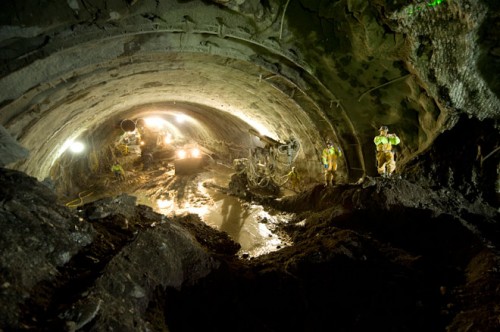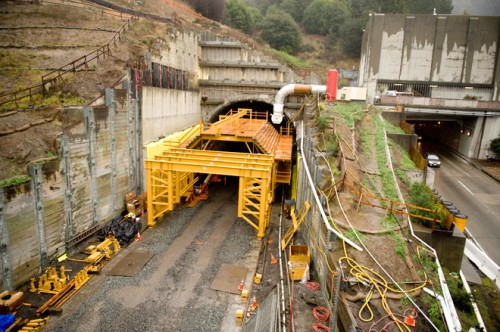
Building a modern-day tunnel in one of the country’s most active seismic zones starts with a mass of bodies. A meeting to discuss the subject begins with four engineering experts, and a Caltrans spokesperson.
What Pat Hipley, Gursharnjeet Cheema, Ben Edalati, Sean Coughlin and Ivy Morrison say about the $402 million project that promises to erase the daily parking lot known as California’s Highway 24 with a swift-flowing commute. The all-new fourth bore might be the safest spot in the San Francisco Bay Area, even in the event of “the big one”.
Buried in the rocky depths of the Oakland/Berkeley Hills, Caldecott Tunnel is just 0.9 miles from the active Hayward Fault. The tunnel being considered a, “lifeline structure,” the seismic criteria required 3-D simulations to test deformation of the tunnel’s double-layer rebar cage lining. Twenty-five inch thick lining is composed of 15 inches of thin,flexible steel and approximately 10 inches of “codified” shotcrete, it’s designed to withstand vertical and horizontal forces.
Due to the mish-mashed, always-moving strata, actual excavation required special ventilation, a massive, custom-built 130-ton drill, and a technique known as the New Austrian Tunneling Method. This method requires intimate knowledge of the hardness and variability of a tunnel bore’s surrounding geology, which indicates the stress applied and dictates when supports must be erected during excavation.
The tunnel is scheduled to be open in 2013, the Operations and Maintenance Center (OMC) — a two-story structure above the tunnel’s west portals — will be the repository of all things connected. Hipley, who works with the California Geological Survey to maintain the bridges throughout the state, describes the bore’s Strong Seismic Motion Detectors.“The recorder’s in a fire niche, mounted in a recessed cabinet in the concrete,” he begins. “Detectors are at three quarter points and at each end and are wired back to the recorder. They measure acceleration: longitudinal, transverse, and vertical.” “The recorder has a 30-second buffer,” Coughlin explains, “it’s erasing the data, until a trigger hits, then it goes back and — boom – it captures data permanently.”

A 4.0 earthquake would generate about 1.8 inches of movement. “We don’t think they’ll be much movement, because the tunnel is within a mountain,” he says.
“A tunnel is inherently stable; it moves with the hill,” says Coughlin. “You’re more likely to trigger a [walk-through] inspection because of a panel falling from the ceiling or the pavement bucking.”
“People will be more concerned with the bridges than the tunnel,” Hipley interjects.
“A bridge is like pushing someone on a swing, it’s going to go higher and higher; it’s called ‘harmonic vibration.’ But a mountain, it’s going to want to stop moving.”
Fire, which all of the experts agree poses more danger than earthquakes.
Linear heat detectors, cameras, jet fans and cross passages with intelligent control systems between bores three and four will improve a mass evacuation in the event of a fire or earthquake. Seventeen cameras in the new bore will transmit vital information to emergency responders. Variable message signs will run real-time, tunnel-specific updates and radio rebroadcast will allow fire departments to use a separate frequency (the absence of this was significant in the 1991 Oakland fire). Announcements to motorists will be broadcast regardless of AM or FM tuning and inner-tunnel repeater antennae will magnify cellular signals.
The OMC will feed information to Caltrans’ central Traffic Management Center and the California Highway Patrol within seconds, Edalati explains, but stops just short of delving into the security details.
Caldecott Tunnel Fourth-bore will be one of the most advanced, tech-laden tunnels in the world — and will also be one of the safest.
Read the full article here.
